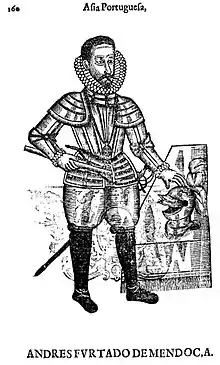André Furtado de Mendonça
André Furtado de Mendonça (1558 – 1 April 1611) was a captain and governor of Portuguese India, and a military commander during Portuguese expansion into Ceylon, India, Indonesia and Malacca.
André Furtado de Mendonça | |
|---|---|
 | |
| Governor of Portuguese India | |
| In office 1609[1][2] – 1609 or 1610 | |
| Monarch | Philip II of Portugal |
| Preceded by | Aleixo de Menezes |
| Succeeded by | Rui Lourenço de Távora |
| Personal details | |
| Born | 1558 Lisbon, Kingdom of Portugal |
| Died | 1611 (aged 52–53) Kingdom of Portugal |
| Military service | |
| Allegiance | Portuguese Empire |
| Battles/wars | Siege of Malacca (1606) Battle of Bantam Battle of Flores |
Biography
He was a son of Afonso Furtado Mendoça, commander of Beja and Rio Maior and D. Joana Sousa. André Furtado was curious to develop combat knowledge and he started to study combat, meteorology and oceanography and cartography when he was 18 years old. He joined the military and became a successful captain at the age of 25. He served some of the Portuguese colonial countries in the Indian Ocean for the Portuguese Empire.
Portuguese Ceylon
André Furtado de Mendonça led the forces of a company of 1,400 Portuguese and 3,000 lascarins against King Puviraja Pandaram as the second expedition in Mannar and gained victory, and continued his campaign to the heartland of the Jaffna kingdom.[3] Captain André Furtado killed king Puvirasa Pandaram in 1591.[3][4][5][6] After the death of Puvirasa Pandaram, his son Ethirimana Cinkam was installed as the ruler by André Furtado. It created Portuguese overlordship in the region including freedom to Catholic Christian missions. Earlier, Christian missionaries were not allowed during the rule of Puvirasa Pandaram. Gradually, the incumbent king resisted Portuguese overlordship until he was ousted and hanged by Filipe de Oliveira in 1619.[7]: 166
Portuguese India
In 1598, he destroyed a fleet of Kunjali Marakkar naval captain of Zamorin of Calicut, and in 1600 Mendonça attacked and captured his fortress.[8]
Portuguese Ambon and the Moluccas
Between 1601 and 1603, Furtado de Mendonça served as captain-general of the Southern Sea, and succeeded in expelling the Dutch from Ambon and Tidore, where the Portuguese held fortresses, and secured Portuguese holdings in the region against hostile native lords.
Portuguese Malacca
In April 1606, Portuguese forces under the captainship of André Furtado were besieged in Malacca by a Dutch fleet under the command of Cornelis Matelief de Jonge. Portuguese forces were no match to Dutch due to disproportional size of men and vessels. However, they managed to resist the besiegers until August 1606 and received support from Viceroy Martim Afonso de Castro.[9]
Portuguese India
André Furtado engaged with several battles in India, including fierce battle with Kunhali Marakkar. His forces bombarded Marakkar fort from the sea while allies Samoodiri attacked it from the land in 1600. Kunjali Marakkar surrendered to Samoothiri as he lost the battle.[10] Finally, the Portuguese seized the Kunjali, against the terms of the surrender, during a tumult caused by an enemy attack. Then Furtado ordered the fort and the town razed, the Kunjali executed, quartered, and his body displayed on a pike.[11]
After the death of viceroy D. João Pereira Forjaz in 1609, André Furtado became the governor of Portuguese India for only three months until the arrival of new viceroy Rui Lourenço Tavora.[12]: 187 [13]
Death
He died due to illness in April 1611 and buried at the church of Covenant of Grace (Portuguese: Convento da Graça) in Lisbon.[14]
See also
References
- Danvers, Frederick Charles (1894). The Portuguese in India: Being a History of the Rise and Decline of Their Eastern Empire. Vol. 2. London: W. H. Allen & Co. Appendix B, p. 487 – via Archive.org.
- Stephens, Henry Morse (1892). Albuquerque. Rulers of India, vol. 4. Oxford: Clarendon Press. p. 13 – via Archive.org.
- "The Karava Singhe Dynasty of Jaffna". Karava of Sri Lanka. Retrieved 13 April 2014.
- Abeysinghe, Tikiri (1986). Jaffna under the Portuguese (PDF). Colombo: Lake House. pp. 2, 3. ISBN 955-552-000-3. Archived from the original (PDF) on 14 April 2014.
- Martyn, John H. (2003). Notes on Jaffna: Chronological, Historical, Biographical. Chennai: Asian Educational Services. pp. 2, 138.
- Rajasingham, K. T. (3 July 2005). "Portuguese: Religious Conversion and Ending Tamils' Sovereignty". Asian Tribune. Archived from the original on 14 April 2014. Retrieved 13 April 2014.
- de Silva, K. M. (1981). A History of Sri Lanka. London: C. Hurst & Company. ISBN 0-905838-50-5 – via Archive.org.
- André Furtado de Mendonça - Portugal, Dicionário Histórico
- Jaques, Tony (2007). Dictionary of Battles and Sieges: A Guide to 8,500 Battles from Antiquity through the Twenty-first Century. Vol. 2: F-O. Westport, Connecticut: Greenwood Press. p. 620. ISBN 978-0-313-33538-9.
- "T'ien Hsia Monthly". T'ien Hsia Monthly. Vol. 9. 1939.
- Murkot Ramunny (1993). Ezhimala: The Abode of the Naval Academy. New Delhi: Northern Book Centre. p. 43. ISBN 81-7211-052-9.
- Faria e Sousa, Manuel de (1695). Ásia portuguesa (in Spanish). Vol. 3. Lisboa: en la officina de Antonio Craesbeeck demello.
- "Furtado de Mendonça". Portugal: Dicionário Histórico (in Portuguese). Retrieved 13 April 2014.
- "André Furtado de Mendonça, 37º Gov.or da Índia (1558–1611)". Geni. Retrieved 7 May 2014.
.svg.png.webp)